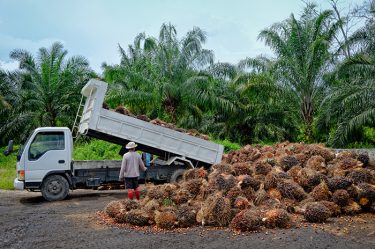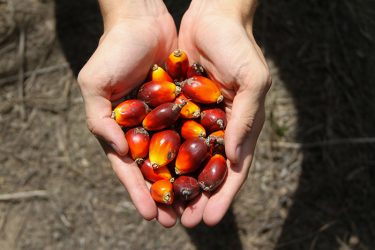
By Lana Sweeten-Shults
GCU News Bureau

Some 9,294 miles from the Phoenix Sonoran Desert, the red-and-white-blister-spotted corpse flower – spanning 40 inches wide and weighing in at a hefty 22 pounds -- holds stubbornly to the floor of the Sumatran rainforest, a sprawling, verdant, rich, soupy ecosystem of mangroves and durian, teak and woody rattan, ironwood and towering 35-foot palm trees.
It was on one of those palm trees that a bird’s nest fern the size of a Volkswagen Beetle settled, collecting water from its host.
Oddly, that a fern could grow to the size of a small car wasn’t what amazed scientists.
“A single bird’s nest fern the size of a car can alter climate in a 3-mile radius by more than 2 degrees,” said Rachel Pikstein, instructor in the Grand Canyon University Biology Department.
That discovery created such an “Oh-my-goodness-Martha!" moment that it started the wheels turning for scientists with the BEFTA Program (that’s the Biodiversity and Ecosystem Function in Tropical Agriculture Program). Its aim is to understand how oil palm ecosystems work and to help the oil palm industry – an industry under scrutiny for its destruction of the rainforest -- become more sustainable.

Scientists started to think, what can we do to make sure those car-sized ferns don’t disappear so they can continue to have a say in the world? What can we do to preserve the ecological wonder that is the rainforest? And, at the same time, how can we realistically help Indonesian farmers?
It’s a program Pikstein became involved with in the summer of 2016 as a visiting scientist at Cambridge University after completing her master’s degree. It is through her connection with BEFTA that GCU’s science students have been able to contribute to that organization’s research.
A GCU Research and Design Program team in the Pikstein Lab has spent the last three years researching more than 120 Indonesian rainforest understory plants, which for oil palm farms are all the plants on that plot of land except for the crop being grown. The research is detailed in a plant guidebook, which is in the editing stage, designed to help oil palm farmers farm in a more rainforest-friendly way.
It started with a dream
Pikstein dreamed about studying at Cambridge. Although that wasn’t to be, she tried another route: “I sent a bunch of emails and asked if they’d be willing to let me come work with them because it had been my dream.”

One of her emails reached Dr. Edgar Turner, insect curator at the University of Cambridge’s Museum of Zoology. He invited her to the university to help process the data that researchers collected in two trips to Indonesia over the summer. Under the mentorship of Turner and Dr. Jason Head, co-discoverer of monster snake the Titanoboa, not only did she catalogue spiders, but she worked on an understory vegetation project (a paper on which she is listed as an author was published in 2019).
Just before she returned to America, she was tapped to help out with one more project.
“They said, ‘We want you to understand this. They gave me this huge list of plants and basically said, would you and your students like to make a guidebook that we can publish that will be used as a reference not only for the researchers but for the farmers in the industry?’”
Pikstein and her students at GCU – alumni Laura Eichenmuller, Kelly Gaines, Jordyn Cobb, Gian Luigi Jequinto, Hannah David and junior Briana Munoz -- jumped at the chance even though Indonesia and the oil palm industry seem like far-away concerns that have nothing to do with life here.
But that couldn’t be further from the truth.
A contributor of deforestation

Palm oil, an edible vegetable oil that comes from the fruit of oil palm trees, is ubiquitous.
“It’s in lipstick, shampoo, soap. It can be found in packaged bread, chocolate, detergent, pizza. It’s in so many of these products,” said Hannah David, team lead in 2019-20 of the GCU student researchers on the project and now a master’s student in forensic science at the University of California-Davis. It’s also in animal feed and is used as a biofuel.
According to the World Wildlife Fund, palm oil is in nearly 50% of the packaged products found in supermarkets, likely because the world’s most popular food oil -- often listed on packaging as vegetable oil – is so versatile. It’s odorless and colorless and doesn’t alter the taste or look of food. It gives products a longer shelf life and is semi-solid at room temperature, so it helps food retain a certain spreadability. It also is less saturated than butter and has no trans fats.
For farmers, the crop requires less land to grow, and there’s the economic impact of the crop.
But here’s the problem: Palm oil is a major contributor of deforestation.

“They’re seeing the profit but not realizing they’re taking away the very diverse (rainforest) plants,” David said.
Rainforests in Indonesia, the largest palm oil producer in the world (it supplied 56% of the world’s palm oil in 2018), are burned to make way for oil palm plantations, causing not only deforestation but carbon dioxide-fueled pollution that irritates the eyes and skin. Officials say 80% of the fires in Indonesia are set to clear land for oil palm plantations.
And as the rainforests burn, animals who live in them, such as the Orangutan, pygmy elephant and Sumatran rhino, are losing their habitats.
Honors College student Briana Munoz, a junior biology major and researcher on the project, learned about the oil palm industry and its effects on the environment when she was just a freshman in high school.
So when she heard at the end of her college freshman year about this particular RDP Project to create a plant guidebook, she was in.
“I think it’s a really cool way to have my voice be heard about something that I just really care about,” said Munoz, who wants to go to veterinary school and has volunteered at the Phoenix Zoo and interned at the Wildlife World Zoo, among others.

Munoz is well versed in what has happened to the Indonesian rainforest’s wildlife. Sumatran rhinos have become regionally extinct in Malaysia, in part because of palm oil harvesting, she said, and “with Orangutans, their habitat has decreased between 60% and 80% since 1990, when the palm oil industry started to take off.”
But Munoz also knows the reality: Palm oil is an important product to farmers and their families and to the economic growth of Indonesia, which until recently was classified as a developing country.
“Palm oil in itself is not inherently a bad thing. It’s just the way people have been producing it recently.”
The guidebook

In the guidebook, the team details 120-plus plants, from the Axonopus compressus, or blanket grass, to a climbing shrub called the Cissus hastata.
Photos accompany a description of the plant, its Latin name, if it’s a weed, if it’s used for medicinal purposes, where it’s natively found, its toxicity, its benefits and whether it’s considered invasive.
David said one of the plants that stuck with her is the Polygala paniculate, or the root beer plant. “The roots actually smell like root beer because of the compound methyl salicylate, which is commonly found in root beer.”
Putting together the guide was a lot of work, the student researchers said, since a lot of the plants are not common to the U.S. and some were previously undescribed.
“But in the end, we were able to pull together very well,” Munoz added.
Once revisions are complete, the plant guide will be sent to Cambridge for feedback and approval before it is published.

“The guide is giving people an extra option,” Munoz said, of how to farm in more sustainable ways – a reason co-researcher David said she wanted to be a part of the project. She, too, likes to research ways to be sustainable and “be nice to Mother Earth.”
“What my students will tell you, what they’ve always told me, is why they love this project. It’s because it’s not just research on plants,” Pikstein said. It focuses on a bigger problem that everyone thinks no one can do anything about. “ … They said, the thing was, with this project, we got to be a part of that. We’re helping to contribute to saving a 250-million-year-old rainforest across the world.”
She added, “It’s the Christian worldview of helping another culture, helping the animals, preserving God’s place. … As they told me, what they saw was that they were contributing to a greater good.”
GCU senior writer Lana Sweeten-Shults can be reached at [email protected] or at 602-639-7901.
Connect to the Pikstein Lab on Twitter: @PiksteinLab_GCU
****
Related content:
GCU Today: “Owl conservation team hatches new nest box design”
GCU Today: Game and fish liaison casts his line at GCU
GCU Today: Science course dances to beat of different drummer
GCU Today: GCU steps up for black-footed ferret count
GCU Today: Professors unleash inner fan boy, girl at Fan Fusion















